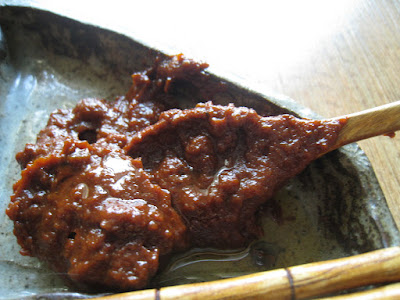Even such a deep experience, though, fails to address what is for me the most important question: what was the effect of my meal on the earth and all the other beings on it? Did it do more good than harm? Are the practices that brought it about sustainable? Are my choices contributing to others' ability to eat well, or am I detracting from it? Of course I want my food to bring happiness and wellbeing to me; but if it does so at the cost of sickness, deprivation, or destruction for others, I'd prefer to opt out.
Luckily, we're not caught up in some zero-sum game in which our health necessarily results in other's misery. It is possible for eating to benefit the earth and everybody on it. Or, more accurately, it's possible for farming to. Good farming, on a small scale, done with care, attention, knowledge, respect, and patience, can rehabilitate land, recover topsoil, recreate space for animals to graze on, and restore health to people. Team Happy Bear wanted to see this kind of work up close, in context, and in action, so Hansik graciously offered to take us out of Jeongju and into Jeong-eup to meet Lee Hee-cheon.
Meeting Farmer Lee
Farmer Lee started 백학농원 (White Crane Farm) some-teen years ago (that's a direct quote, not my memory faltering) because he wanted to feed his family food that was healthy and safe. I asked him if he had done conventional farming before switching over to organic, to which he replied, more or less "I would never farm anything except organic. What's the point?" Here's a dude who understands what it's all about! Non-organic farming methods, in the long run, create and exacerbate a host of seemingly disconnected problems, from oil depletion to water pollution, from topsoil loss to political instability, from starvation to obesity. Organic, sustainable agriculture is the only foundation upon which we'll be able to build strong, healthy, enduring communities in the future. If I were more of a historian, I might also try to make a similar claim about the past. In any case, Farmer Lee said that he had been successful: his kids are healthy and energetic, and his land is becoming more fertile year after year.
It would take a full year on an organic farm to really begin understanding anything, but, unfortunately, we only had a few hours together with Mr. Lee, so we quickly got down to business in the cabbage patch. He explained that he doesn't use any chemical pesticides or fertilizers. Instead, to control bugs, he creeps through his fields, searches for clues like eaten-up leaves and little insect droppings, spots the invaders, and plucks them out with a pair of chopsticks. It does sound like a lot of work, but actually, it's not particularly harmful to eat a leaf that bugs have already nibbled on. In fact, Mr. Lee says, the fact that bugs eat it means it's probably good enough for us, too. Would you want to eat something that even a roach wouldn't go near?
This is neither here nor there, but it was at about this point that Mr. Lee picked a grub off of a piece of cabbage and said that it was probably pretty healthy, since it had been feasting on organic food. Greg then took the grub and scarfed it, more or less blowing the farmer's mind. Apparently he hadn't been given the full dossier on Team HappyBear!
Andy hoists a cabbage-trophy. In less than 4 hours, it will be Kimchi...
After harvesting some cabbages together, we walked down the hill, flanked on either side by persimmon trees just about ready to lose their leaves to the autumn and their fruits to hungry tourists. We moved on to the next stop: the carrot and garlic patch. The five of us all planted garlic together by pushing cloves about an inch into the dirt then covering them back up, while Mr. Lee explained that, as deplorable as the plastic (they call it "vinyl mulch" here) is, it helps the plants a lot by retaining moisture and warmth and keeping out weeds, which essentially steal nutrition from the garlic, keeping it from growing as big as it might. It's still not clear to me whether this kind of farming can really be called "organic" in the fullest sense of the word, but it's a whole lot better than the alternative.Me and Tanya after eating a fresh clove of garlic each, wishing the cameras were equipped with smell-o-vision technology.
After planting garlic, we dug up some carrots, scrubbed them off on our pants, and, much to the amazement of Farmer Lee and the Hanisk crew, chowed down on the spot. Some were a little concerned about the dirt, but we told them: not only is organic produce healthy; so is the soil it's grown in. After all, all the vitamins and minerals in fruits and veggies come from one of two places: the soil, or chemical reactions within the plant. (Botanist friends: correct me if I'm wrong here). Our smiles and "mmmmms" probably did more than our arguments to overcome the crew's skepticism, but either way, they joined us, munching on the freshest and healthiest carrots they'd probably ever had. Unfortunately, I was too busy eating to take any pictures.















